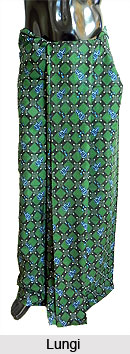Lungi, a kind of loincloth, stitched, unlike a Dhoti, resembles a skirt. Its upper border , is tucked into the waist, after tying a single or multiple knots.
 Regarding the diverse hues of a Lungi, there exists a popular belief, that a Lungi, white in shade, signifies it as an attire for a formal occasion, while the one in colours or designs, is perfectly suitable for festive revelry .
Regarding the diverse hues of a Lungi, there exists a popular belief, that a Lungi, white in shade, signifies it as an attire for a formal occasion, while the one in colours or designs, is perfectly suitable for festive revelry .
A lungi can be single-coloured, or in stripes, or in motif-prints. To be very precise, there is no hard and fast rule, pertaining to the pattern of a Lungi. However, stripes in dual colours, against a background colour is the most popular type. Mostly, Lungis, are invested with black and white stripes, at the upper and the lower margins.
In West Bengal, Goa, Kerala, of India, Lungi, ranks high in the list ofb favourites. Infact, in the coastal areas, where, the fishermen setles down, to earn their livelihood, Lungi is the patent costume. An interesting truth about the use of Lungi in fishing community is that, is that it can be utilised as a sail, whenever required, apart from being a cosy garment for the body. So Lungi, is an integral part of their everyday life, suiting the best, their purposes.
Indeed, the daily domestic-attire for the Islamic people is Lungi. They are mostly noticeable in Lungi. There prevails a custom among them, to, gift lungis of various material, namely, cotton, or silk lungis, enriched with ornate design to the groom.
At Goa, the regional costume for fishermen men is Lungi.
 In kerala, lungi is put in by both men and women. There, Lungi is th traditional costume for the labour-class.
In kerala, lungi is put in by both men and women. There, Lungi is th traditional costume for the labour-class.
In Assam, the Mekhla, serving as a petti-coat, for the Assamese women, is a sarong, or a type of Lungi.
Lungi is a popular dresscode among the tribal clans of India. In Arunachal Pradesh, the common costume of the men of Tangsa tribe is a green lungi with yellow, red and white interweave.
Lungi, is even used by the men of other sects, due to the comfort-friendly factor. For instance, in Bengal, some men at home, feel very much easy in Lungis.
Lungi, as one of the ethnic wears of India, drives home the unavoidable truth, that clothes are not only meant for decency, but for utility, too.





















